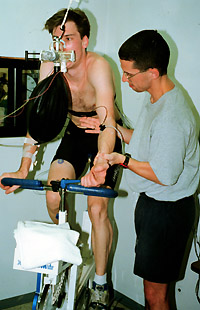This is an archived article. For the latest news, go to the Advance Homepage. For more archives, go to the Advance Archive/Search Page  | ||
|
When NHL goalie Sean Burke stepped on the ice in Miami Arena in March 1995, the outside temperature was 85 degrees. At ice level, the arena was hot and extremely humid. Throughout the game Burke lost a lot of fluid and found it difficult keeping himself hydrated. He ended up in the hospital for two hours receiving an intravenous solution to replace lost fluid. If Burke had received intravenous fluids between periods, would that have made a difference in his performance. "Many coaches, trainers and athletes believe so, because IV fluid administration is commonly used to treat heat-related illnesses," says Carl Maresh, a professor of exercise science. "They believe that if lost fluid is replaced by going directly into the circulation, athletes will recover more quickly and probably perform better, but there has been very little research to substantiate these claims." Maresh and his colleague Larry Armstrong, an associate professor of exercise science, conducted a study with cyclists to determine if oral or intravenous hydration has a better effect on an athlete's performance once they become dehydrated. After five months of carefully examining the cyclists, Maresh and Armstrong found there was no difference. In their first study, the cyclists were dehydrated to minus 4 percent of their body weight because endurance performance is affected at minus 3 percent. Once the cyclists were dehydrated, they were given two hours to rehydrate intravenously or orally. The cyclists were then put into a heat chamber at 95 degrees to exercise at 50 percent of their maximum capability. "We had them ride as long as they could before exhaustion," Maresh says. A week later, they put the cyclists through the same regimen. "What was interesting," he says, "Is that the cyclists exercised for a longer period of time ... 84 minutes following oral rehydration but only 77 minutes after IV rehydration. That was a surprise to us."
So the two researchers decided to test another group of cyclists using a different approach. This time they gave the cyclists only 30 minutes to rehydrate and had them exercise at 70 percent of their maximal capacity. Results showed that those who had their body fluids replenished orally were able to exercise for 34 minutes, whereas the intravenous users went only for 29.5 minutes. "These results speak against what people would expect," says Maresh. Maresh and Armstrong say that rehydrating by drinking fluids has a number of advantages, not least that it is safer. At halftime, you can go into NFL or professional soccer locker rooms and see players being administered IV infusions, Armstrong says. "The concern about IV rehydration has been the capability of those who are administering the IVs. Are they phlebotomists, athletic trainers or possibly untrained managers." Maresh believes another risk associated with IV administration - hitting a nerve or missing a vein - may be averted through rehydrating by drinking. He adds that there may also be a psychological component to the issue. "The cyclists felt better exercising after consuming water than after IV treatment," Maresh says. "They also reported that their thirst and heat sensations were diminished if they were able to drink. Luis Mocete |

